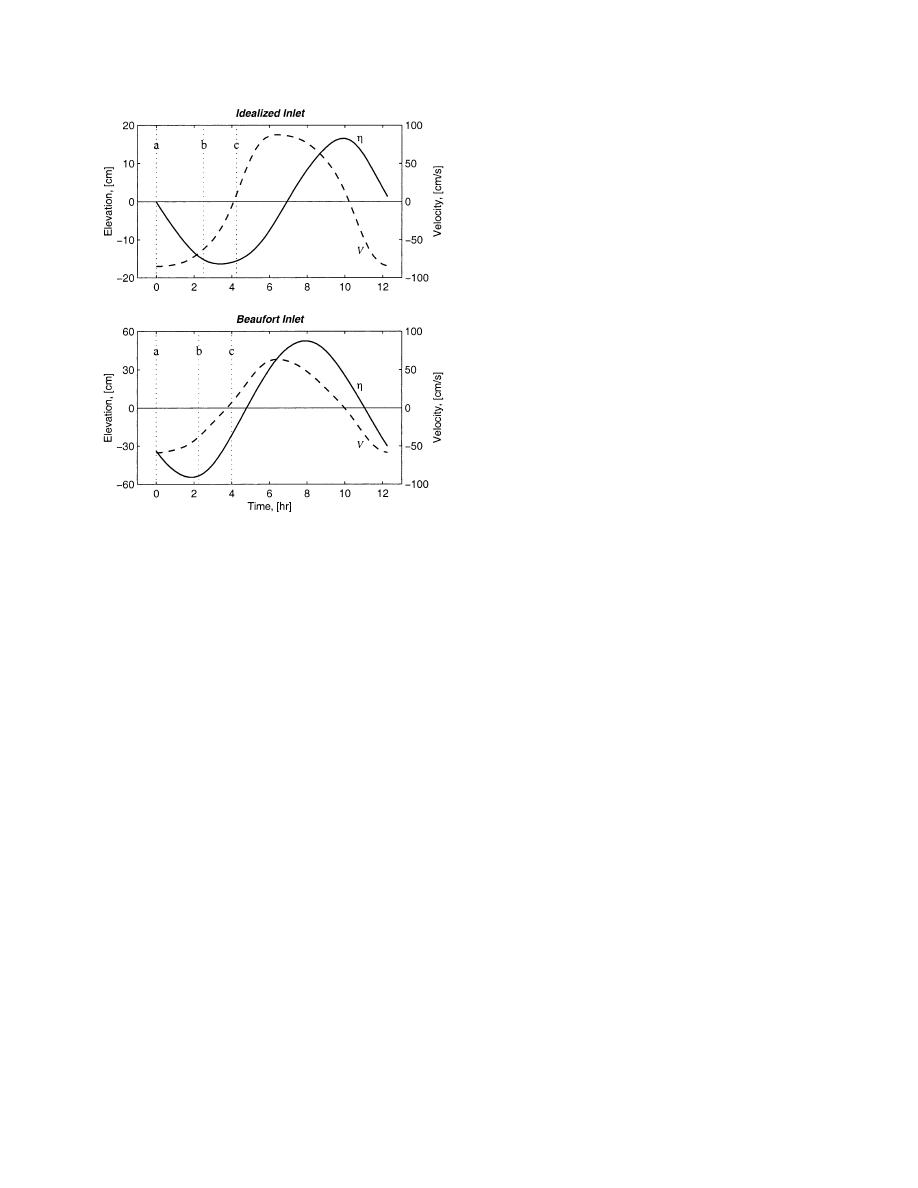
919
APRIL 2003
HENCH AND LUETTICH
a dome of water across the inlet where the water surface
has adjusted to opposing centrifugal accelerations. Mod-
el results indicate that the water level is about 3 cm
higher at the inlet center than at the sides (see elevation
contours in Fig. 5b). The centrifugal acceleration and
cross-stream pressure gradient balance relaxes within
about 1 km from the inlet. Coriolis (Fig. 5k) is strongest
(in the absolute sense) in the inlet throat, where stream-
wise velocities are largest, but is relatively weak com-
pared to the centrifugal acceleration and normal direc-
tion pressure gradient. Further away from the inlet Cor-
iolis increases in relative importance (see section 4d
below).
Beaufort Inlet maximum ebb momentum fluxes are
shown in Fig. 6. As with the idealized inlet, flow is near
steady state and local and rotary accelerations (Figs.
6d,h) are close to zero in the vicinity of the inlet. The
exception is in the offshore portion of the deep navi-
gation channel where flow speeds are still increasing.
Near-inlet streamwise advective accelerations (Fig. 6e)
are quite strong; positive as the flow from the sound
enters the inlet and negative as the flow exits the inlet.
In contrast to the idealized inlet, there are marked lo-
calized areas of negative advective acceleration at the
tips of headland features associated with flow separa-
FIG. 4. Inlet elevation ( ) and velocity (V ) time series at the inlet
tion, which are balanced by local adverse pressure gra-
centers for one tidal cycle: (top) idealized; (bottom) Beaufort. Times
dients and bottom friction (Figs. 6e,f,g). These local
selected for detailed momentum balance analysis are indicated with
dynamics are similar to those found around the single
vertical lines: (a) maximum ebb, (b) midebb (1.50 h before slack),
headland of Signell and Geyer (1991). Comparable to
and (c) slack before flood (0.25 h after slack).
the idealized inlet there is a 6-cm elevation difference
between the sound and ocean, and this streamwise pres-
advective acceleration (Fig. 5e) is large and positive as
sure gradient drives the ebb. Outside the inlet is a region
the flow enters the inlet from the sound, and large and
of large streamwise deceleration and positive (i.e., ad-
negative as the flow exits. A large negative (i.e., fa-
verse) pressure gradient arising from a Bernoulli effect.
vorable) streamwise pressure gradient drives the flow
Unlike the idealized inlet, this region is displaced south
from the sound toward the inlet (Fig. 5f). (There is about
of the geometric center of the inlet. On the sound side,
6-cm elevation difference between the sound and
bottom friction is greatest in the deep navigation channel
ocean.) The water surface in the inlet dips as the flow
west of the inlet and in the narrow slough east of the
accelerates through the inlet (see Fig. 5b), but the flow
inlet (Fig. 6g). This term rapidly diminishes in impor-
remains subcritical (maximum Froude numbers 0.8).
tance away from the inlet, where the dynamics more
This Bernoulli-type effect (i.e., streamwise advection
closely follow linear wave theory.
pressure gradient balance) yields an adverse pressure
In the cross-stream direction, centrifugal acceleration
gradient as the flow exits the inlet (Fig. 5f). Outside the
(Fig. 6i) is largest where flow from the sound turns
inlet throat transition area are two distinct dynamical
toward the inlet throat and follows a pattern remarkably
zones. In the ebb jet, bottom friction balances the
similar to the idealized inlet. Offshore of the inlet the
streamwise advective acceleration (Figs. 5e,g), while in
navigation channel turns slightly westward, so flow ex-
the sink region on the sound side streamwise pressure
iting the inlet's east side veers toward the west, and the
gradient balances streamwise advective acceleration
centrifugal acceleration changes sign to an anticyclonic
(Figs. 5e,f).
orientation. As with the idealized inlet, the centrifugal
In the direction normal to the flow, the primary bal-
accelerationpressure gradient balance yields a dome of
ance is between centrifugal acceleration (Fig. 5i) and
high water across the inlet throat. However unlike the
the cross-stream pressure gradient (Fig. 5j). On the east
idealized inlet, the dome is highly asymmetric, with a
side of the inlet, centrifugal acceleration is positive,
3-cm elevation difference from the west side to the cen-
reflecting cyclonic turning of the flow; the converse is
ter, and an 8-cm difference from the east side to the
true on the west side. The cross-stream pressure gradient
center (Fig. 6b). The asymmetry is due to stronger cen-
is positive on the inlet's west side (indicating an upward
smaller. Coriolis (Fig. 6k) plays a secondary role to the
slope eastward) and negative on the inlet's east side
centrifugal acceleration and cross-stream pressure gra-
(indicating a downward slope eastward). Thus there is




 Previous Page
Previous Page
